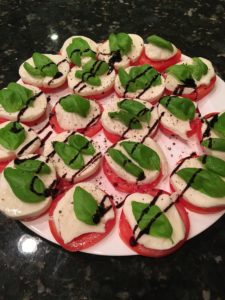Living by the Seasons – Holy Basil!
June is here, bringing with it the longest days of the year in the Northern hemisphere and summer solstice (June 21st this year), a goodbye to spring. June also marks the beginning of basil season, which runs until September in much of the United States. We love basil at our household (“albahaca” in Spanish, for those of you who want to learn your foods in a romance language). I have thus chosen basil as the featured ingredient to kick-off the first of my summer posts.
Lets Geek Out
Speaking to its greatness, the word “basil” comes from the ancient Greek word “basilikon (phyton)”, meaning “royal (plant)”. Basil has a refreshing and crisp quality to it, like mint, which is in the same Lamiacae plant family. Basil is native to India, Asia and Africa and is used frequently in Chinese, Iranian, Italian and Thai cuisine. This herb is sensitive to the cold and likes direct sunlight, but not for too long (average 6-8 hours should be plenty). It can grow anywhere with nighttime temperatures above 60F for at least two months and prefers soil that is warm and moist – not too wet or too dry. Of the more than 60 varieties of basil, we use sweet basil (Ocimum basilicum) the most for cooking in the United States. Tulsi or holy basil (O. tenuiflorum) is the basil species that is commonly used in supplements and herbal tea.
Is It Good for Me?
Most of us have witnessed the wonderful brightness and aroma of fresh basil but, is it good for us? Most studies regarding basil have been done in animals and more studies in humans are needed to explore this. However, I think there is value in the observations that have been made by our predecessors. Basil contains vitamins and minerals such as calcium, vitamin A, vitamin K, manganese, magnesium, iron, zinc and potassium. In traditional medicine, basil is used to reduce inflammation within the nasal passages and in the treatment of certain insect and animal bites as well as for mental health purposes. It is also a popular folk remedy for nausea. Basil has beneficial plant compounds such as eugenol (also found in cloves) which, in vitro (in a lab), has been found to have antibacterial, antifungal and antioxidant properties. Some of the potential health benefits of sweet basil include reduction of fasting blood sugar, cholesterol and triglycerides as well blood pressure reduction. Potential benefits of tulsi (holy basil) also include reducing blood sugar and improving general emotional stress symptoms. It is important to note that basil is high in vitamin K, which helps to make various proteins that are needed for blood clotting, and high intake could interfere with medications for blood thinning such as warfarin. If you are taking medication to lower your blood pressure and/or blood sugar, use caution when using basil supplements as these could further lower your blood pressure and glucose. Tulsi should also be avoided in pregnancy or if trying to get pregnant as animal studies suggest tulsi supplements may negatively affect sperm and trigger contractions in pregnancy.
Off to the Garden (Or Market) We Go
When selecting basil, look for vibrant, deep green leaves free of dark spots and avoid basil that is drooping, wilting, or yellowing. Ever been annoyed by darkening basil leaves just a few days after you bring them home? Consider trimming the stems and placing them in a jar one-third to one-half filled with water, just like you would with cut flowers, then loosely covering the jar with a plastic bag and leaving it at room temperature.
Lets Get Cooking!
One of my favorite go-to quick dishes during summer is caprese salad, or insalata caprese, as you would order it in Italy. Combine beautiful ripe tomatoes, basil, fresh mozzarella or burrata, olive oil, freshly ground pepper and a bit of salt and you have got yourself a mouthwatering dish. Consider adding a bit of balsamic vinegar and dried oregano for an extra kick of flavor. For those that are not tomato aficionados and have plenty of basil on their hands, pesto may be right down your alley and calls for few ingredients. I am including one of my favorite recipes for pesto from NYT Cooking here.
A tip when using heat (temperature) in cooking with basil: add the leaves toward the end of the process to keep more of the flavor and bright green color in the dish. You can sprinkle chopped fresh basil over soups, salads, fish and seafood dishes. It is also delicious over certain Vietnamese and Thai dishes! If you are in the mood, consider infusing oil with basil… it only takes about 15 minutes of active time and the rest involves letting it rest.
Connecting With Nature
Now that the weather is consistently warm, more of us are excited to get out and enjoy nature without having to bundle up. For me, getting exercise this time of year can simply look like going on walks with my family through our community on weekdays, visiting and walking through the National Arboretum in Northeast DC on the weekend, or taking advantage of seasonal activities such as blueberry picking or DC Open Streets. If you are looking to take on a new sport, consider visiting your community pool for swimming or explore Pickleball, considered the fastest-growing sport in the country from 2019 to 2021.
As always, I hope you had fun learning something new with me and are motivated to introduce healthier habits to your daily routine. Please keep in mind that my content is not a substitute for your physician’s medical advice. When in doubt, you should always consult your physician prior to making any major lifestyle changes, including diet and exercise.
Wishing you good health,


